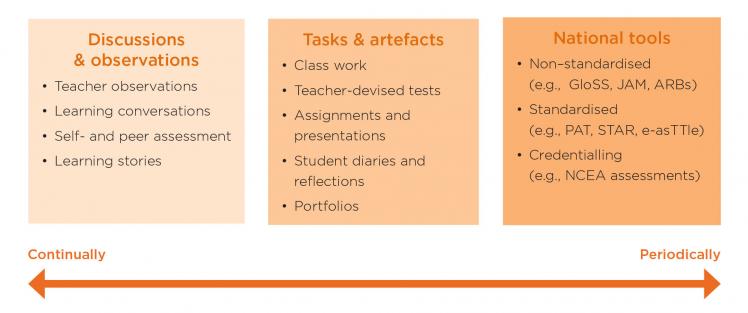A variety of assessment approaches and activities should be used to make the learning of all students visible to themselves and all those in their network of support – their whānau, their teacher(s), their peers and friends, school leaders, and others supporting their learning at school.
The purpose of the assessment will drive the choice of approach. A common purpose is for student and teacher to regularly keep track of learning through informal day-to-day interactions within the classroom, using, for example, learning intentions and success criteria to do so.
Sometimes the purpose will be diagnostic, as in the example of assessment immediately below, which helps the teacher and students identify their next teaching and learning steps. When such assessment information is shared with whānau, it supports them to understand their children’s progress and achievement and to play an active role in their learning.
A science teacher wants to get a better picture of his year 9 class’s understanding of forces. He selects four Assessment Resource Bank tasks, one at each of curriculum levels 2, 3, 4, and 5, and allows the students to choose which task to complete during the period set aside for the assessment. Several students who choose the level 3 task quickly realise it is too easy for them and move on to the level 4 task. Two others realise that the level 3 task they’ve selected is too difficult and move to the level 2 task instead. The teacher uses the results of the assessment to differentiate an upcoming unit on forces, aiming for all students to be challenged and to progress in their understanding of the topic.
At other times, assessments will provide a more formal, big-picture understanding of students’ progress. This kind of information feeds into school-wide assessment data, enabling the school to compare the relative achievement of different student cohorts and to report effectively to the board of trustees and the Ministry of Education.
All the above approaches contribute to the effective use of teaching as inquiry and provide valuable information for both its “focusing inquiry and learning inquiry” (New Zealand Curriculum, page 40). The approaches you choose should result in a rich and reliable picture that illustrates ‘where your students are at’ and ‘what needs to happen next’ and that documents progress across a range of curriculum learning goals and outcomes. As Figure 7 shows, this should involve a broad range of approaches, the most frequently used being focused discussions and observations that support students to self- and peer assess.
Figure 7: Assessment approaches for making learning visible
In addition, specific tasks and artefacts will periodically provide information on where students ‘are at’ in relation to curriculum signposts and standards.
Finally, at specific points in the school year, national tools such as the Assessment Resource Banks (ARBs), GloSS, PATs, and NCEA assessments will provide more formal information about progress and achievement. These national tools are not appropriate for all students. For students with significant learning needs, there are specific frameworks that support teachers to understand where their students are up to in their learning and where they will move to next. The section ‘Supporting Students Working at One Curriculum Level for an Extended Period’ (currently in development) will provide information on these frameworks.
The remainder of this section unpacks the three columns of Figure 7.
The assessment tool selector is a resource for teachers and schools to help them select the most appropriate assessment tool to suit a particular purpose.
Next – Discussions and observations
Published on: 20 Jun 2016
Return to top


